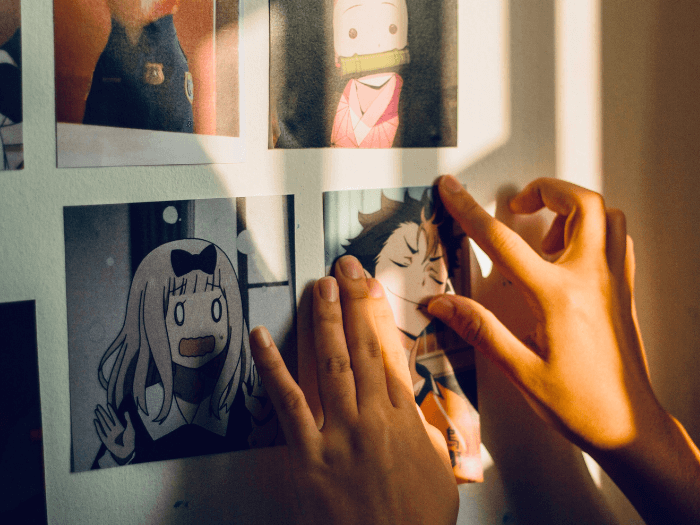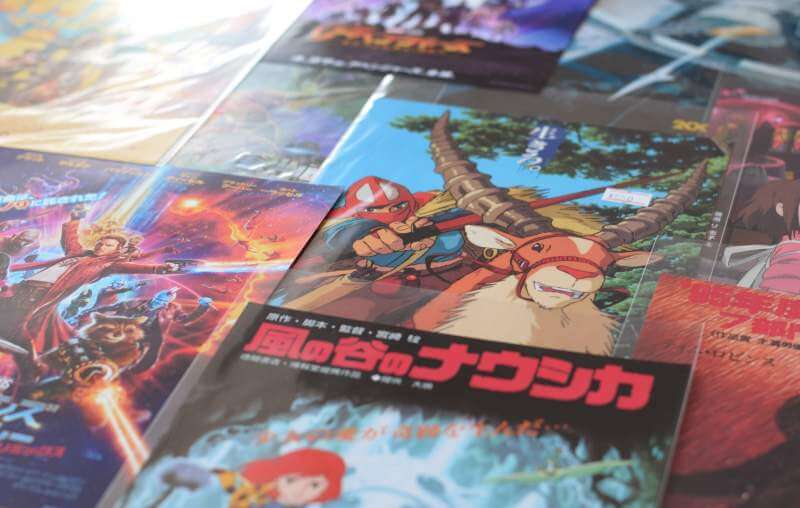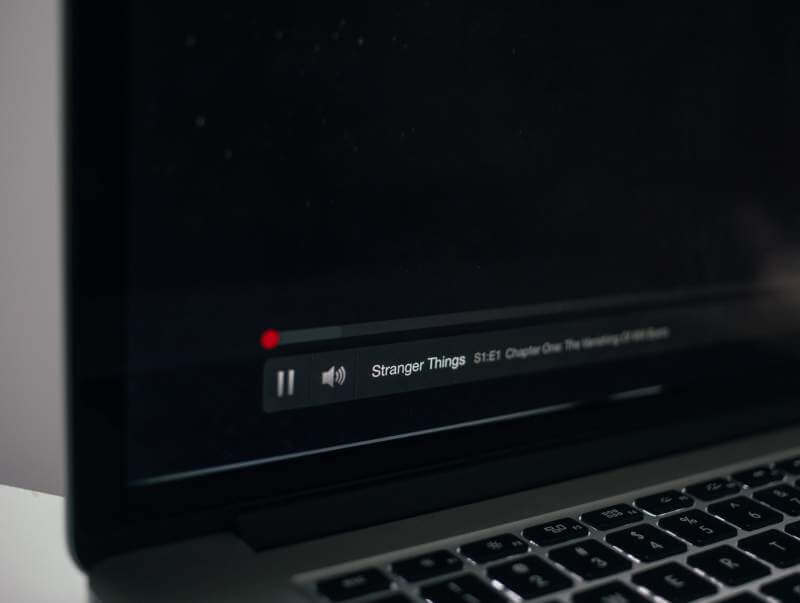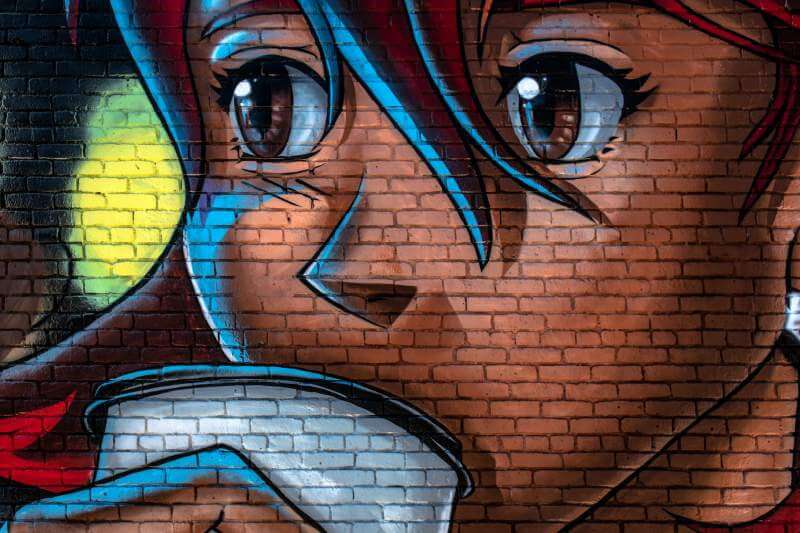
Whether you’re just starting to learn Japanese or have been at it for a while, you might find that one of the toughest areas to practice is your listening skills.
For many of you, access to native Japanese speakers is slim to none. And that means that when it comes time to actually have that Japanese conversation you’ve been practicing for, you might flounder and struggle with comprehension.
Thankfully, there’s an easy way to fix that! Enter anime – a big part of Japanese culture. Japanese anime, short for “animation,” is either hand-drawn or computer-generated animated content. It’s extremely popular in Japan.
And despite stereotypes you might have heard, it’s not just “for kids.” Watching anime is a great way to listen to the language while having fun!
In this post, I'll go into depth about why it's so great to learn Japanese with anime and how to do it right, so you can learn Japanese with movies and shows.
By the way, if you want to learn Japanese fast and have fun while doing it, my top recommendation is Japanese Uncovered which teaches you through StoryLearning®.
With Japanese Uncovered you’ll use my unique StoryLearning® method to learn Japanese naturally through story… not rules. It’s as fun as it is effective and you will speak Japanese in no time!
If you’re ready to get started, click here for a 7-day FREE trial.
Table of Contents
What Is Anime?
Anime is a big part of Japanese culture and simply means animation. Anime shows are cartoons with drawings in a specific style.
The animated shows often deal with serious topics and aren't necessarily for children. Watching Japanese anime can help you gain cultural insights about Japan.
Brief History Of Anime

Anime first appeared in the 1950s and became successful thanks to the comic book style of manga artist Osamu Tezuka. He is often referred to as the “father of manga” and his drawings contributed greatly to the style of anime.
Because anime was designed for the Japanese market, there have always been lots of references to Japanese culture that foreigners may not notice. One example is that anime characters have very large eyes, which in Japan are seen as the window to the soul.
The broad anime themes were intended for children, but as time passed and the popularity of the style grew, deeper themes started to appear in the cartoons.
Along with the more serious themes, there are anime shows about high school students, magical creatures, detective dramas, science fiction, and even sports anime.
The popularity of anime around the world is mainly thanks to Pokémon which captured international attention. Pokémon started in 1996 and has captured the hearts and minds of people across the globe, whether they are Japanese learners or not.
Can You Learn Japanese From Anime?

The short answer is yes! Learning Japanese through Anime is one of the most fun ways for Japanese learners to get started.
Why? Because anime provides one of the key features of successful foreign language learning: immersion. It offers you the opportunity to hear native language speakers talking at a native cadence, which is great for listening practice.
You've noticed that Japanese people talk fast right? Well, did you know that Japanese is one of the world's fastest-spoken languages? Which of course, makes studying Japanese difficult.
By watching anime and hearing Japanese spoken at native speed will help you immensely with the learning process and make it much more possible to learn Japanese!
Learn Japanese With Anime: The Power Of Stories
On top of hearing real-life Japanese in anime, you have visual cues—a story you can follow—that will provide you with helpful context and hints as you attempt to improve your dialogue-related listening comprehension.
Plus, it’s easy and fun to watch anime shows, which serves as a great motivator to keep you learning Japanese. You just have to find out what happens to Kenichi in episode 13!
This is why I teach and learn languages with the StoryLearning® method, because it's so much more fun and effective to learn through stories, not rules!
In addition to—or perhaps more accurately as part of—immersing yourself in real Japanese audio practice through anime, you also equip yourself with an automatic system of stepping stones that will grow and change with you.
How To Learn Japanese With Anime: 3 Learning Tips

If you're looking to up your Japanese level by using anime, you'll need some tools in your back pocket. Check out these top tips to get you started:
1. Tools To Help With Watching Anime
What I'm talking about here are subtitles and other video controls. If you’re brand new to listening to Japanese, you might find it overwhelming to watch a show with native speakers zipping through a conversation at regular speed.
Fear not. You’ve got some controls at your disposal to help, all thanks to the electronic nature of anime.
If, when you start learning Japanese and are having a hard time discerning the words being said, most video players have the option to slow down the video speed. Try popping that down from 100% to 90%.
You’ll barely notice in terms of watching the action flow. But it’ll help those speedy Japanese words to sound more enunciated.

On top of that, you’ve also got the option to turn on the English subtitles (without subtitles, things can be difficult for beginners). This is a great way to ensure you understand what’s being said while listening.
And it’s one of the best immersive methods for learning passively. It allows your brain to understand while also hearing foreign words, tying them together via association with words you already know in your language.
As you progress in your listening skills, try returning the speed to 100% or turning off the English subtitles. Once you feel really confident with your reading, you can turn on the Japanese subtitles to help you practice your understanding of the Japanese characters.
Even if you don’t understand everything, letting your brain actively try to figure out what’s happening will be a huge stepping stone in boosting your listening comprehension.
You can try watching shows you’ve already seen if you’re just starting out. Or, if you’re up for a challenge, try a new show of which you don’t know the plot and see if you can follow along!

2. Look Out For Nuances
Because anime is, in many ways, a reflection of native speakers of Japanese, you’ll have plenty of opportunities to hear standard Japanese phrases and Japanese grammar used in context.
Sometimes, learning about grammar from a book can be less than helpful. Sure, you’ve learned how to ask someone if they want to go to the bookstore. But let’s be real—how often do you actually ask people to go to the bookstore?
Anime provides a lot of useful phrases in everyday contexts that are much more similar to how you might natively encounter them.
Why? Because Japanese anime is made for Japanese people as the primary audience. Things to look out for when watching anime:
Japanese Formality
Remember that there is both formal and informal language in Japanese. So, when you're watching Japanese anime, keep an eye (or rather, an ear) out for things like formality changes.
- Do the anime characters speak differently when they’re talking to their friends vs. when they’re talking to their boss?
- How does this formality change in fiction shows, like those with fantasy creatures in the anime world?
Figuring out when Japanese people think it’s right to speak formally can give you a great view into when you might want to do the same.
Japanese Phrases And Vocabulary
You’ll also have a major opportunity to buff up your vocabulary. You’re going to be encountering a ton of Japanese vocabulary words you’ve never heard before—and that’s great!
Pick out the words and phrases that you think will be most helpful to you and add them to your list. You don’t need to memorise them all. Keep your expectations realistic so you don’t burn yourself out.
Be careful about the words you choose, though. Because anime isn’t real life, it can be goofy in a way that real speakers usually won’t be, and there are even made-up words in anime.
If you hear some unusual Japanese in your favourite anime series, it's probably because it's not something you will hear in the real world.
If you like Naruto, make sure that you don’t pick up on his catchphrase dattebayo. It doesn’t mean anything and is just a quirk of the way the writers decided Naruto should talk.
So double-check the new words you choose to make sure you understand what they mean. If you start imitating anime characters and their made-up words, people won't understand you!
This is good for you, too because research will help you to practice and learn those words more quickly (instead of just writing them down as soon as you hear them and then forgetting about them).
3. Improve Your Japanese Listening And Pronunciation
One of the most helpful features of anime when learning Japanese is hearing intonation. Japanese speakers don’t stress the same parts of a sentence that English speakers, German speakers, or even Spanish speakers do.
Over time, by constantly exposing yourself to spoken Japanese, you’ll begin to develop an ear for the intonation and cadence of a Japanese sentence. Then you can try that out for yourself!
Learn Japanese With Anime Thanks To These 5 Shows & Films

Some anime are better than others when it comes to listening comprehension. The first anime (and manga) some people have tried to use when they learn Japanese with anime (speaking from experience here) is Death Note — bad idea.
The topic of Death Note is very niche and specific. It revolves around highly complex criminal plots and rules. And that means lots of very specialised vocabulary and more unusual Japanese that’s hard to follow for a beginner, like “international criminal police organisation.”
If that’s a topic you’re highly interested in, it may be worth it to check out. But if you’re coming in hoping to improve your Japanese language skills on a basic, general level, try some other shows first.
In general, remember: if you want to learn “standard” Japanese language, it makes sense to stick to places where you’ll hear “standard” Japanese.
That’s going to be more common in high school shows than it is in stories with ghosts, dragons, science fiction and, yes, even giant space robots (looking at you, Gundam).
#1 Polar Bear Café (Shirokuma Café)
If you’re just starting out and are aiming for simpler Japanese language that’s still useful, Shirokuma might be perfect for you.
The plot is about a polar bear who runs a café and loves talking to his friends, a panda, and a penguin.
While it might seem childish, the show is actually a goldmine for casual language and conversation among friends, everyday topics (with bonus life advice!), animal terms, and even wordplay. The polar bear loves simple puns and pranking his customers.
The show is accessible and slow-paced, providing a relaxing but educational viewing experience. Great if you're just starting out with your Japanese learning journey.
#2 Nichijou
If you’re ready to tackle language learning with something a bit more complex when it comes to everyday conversations among friends, Nichijou is probably perfect.
The language spoken by the main characters – high school girls Mio, Yukko, Mai, and Nano is very shorthand, which is a common type of casual Japanese. The characters' speech styles closely mirror what you’d find if you spent time in a Japanese high school.
If this sounds like something that would help you learn at this stage in your listening practice, Nichijou is a fun show detailing the girls’ high school antics—which get pretty nonsensical in a very good way.
Have you ever seen a high school principal suplex a deer?
#3 Pokémon
Yes, it’s the age-old classic for all anime fans! If you want to be the best like no one ever was, Pokémon (or by extension, Digimon, Zoids, Yu-Gi-Oh!, and similar titles) are a great way to immerse yourself in fast Japanese speech.
It's faster-paced than something like Shirokuma without delving deeply into complex language patterns because the shows were made for a younger audience.
So, should you learn Japanese with Pokémon? Of course, if you want to learn at an intermediate level while entering into your own universe.
#4 One Punch Man
Breaking into intermediate-level Japanese and above is One Punch Man, a classic anime show about a hero who can defeat any enemy with just one punch. And how disappointed he is that everything’s over so quickly.
It follows the main character Saitama as he tries to find purpose in his life. And get to the store before they sell out of shrimp tempura.
This goofy and much-beloved anime show is a goldmine for upping your Japanese pronunciation abilities. The phrasing is in both informal pronouns and formal respect levels, making it a well-balanced listening comprehension tool.
From Saitama’s relationship with his pupil (and the casual language that follows) to his interactions with the super formal Association of Heroes (and the proper formality in his speech, of course), One Punch comes highly recommended and diverges away from the typical school-centric vocabulary of many slice-of-life titles.
#5 Studio Ghibli Films
Remember, anime is simply “animation,” not “cartoon TV shows”! The globally famous and incredibly well-respected Ghibli films from Hayao Miyazaki are just about as solid as it gets when it comes to anime to learn Japanese.
They present firmly native Japanese offered with standard line delivery. And thanks to a huge and varied cast of characters across the films, issues like formality, vocabulary, and structuring are all going to be varied and provide a well-rounded exposure to the language.
Learn Japanese With Anime FAQ
Can you learn Japanese with anime?
Yes, but only to a certain extent. Anime can help you pick up common phrases, pronunciation, and casual speech, but it doesn’t teach grammar, reading, or formal language.
To truly learn Japanese, you should combine anime with structured study materials like textbooks, apps, or courses.
Are there any anime that teach Japanese?
Yes! Some anime are easier for learners, such as “Shirokuma Café,” “Doraemon,” and “Sazae-san.” These have simple vocabulary and clear pronunciation. Additionally, anime like “Nihongo de Asobo” is designed to teach Japanese.
Should I learn Japanese because I like anime?
If anime motivates you, it can be a great reason to start learning! However, keep in mind that anime often uses slang, informal speech, and exaggerated expressions that may not be suitable in real-life conversations. A structured approach will help you learn proper Japanese.
Is Pokemon anime good for learning Japanese?
Yes, Pokémon is a good choice for beginners because it uses simple vocabulary and clear speech. However, it may not reflect everyday conversations since it focuses on battles and adventure. Watching it with Japanese subtitles can help improve reading skills too!
Learn Japanese With Anime Now!

So there you have it – pretty much everything you need to know about how to learn Japanese with anime!
Anime offers lots of advantages for you as a Japanese learner. You get to immerse yourself in a story, meaning that you're motivated to watch the next episode of the series. You learn without feeling like you're doing the work.
Your listening skills improve as you spend more time with the spoken language. And you can use built-in tools when you watch to support you as you progress, like subtitles.
You can also add to your vocabulary. And get to grips with tricky features of Japanese, such as formality or intonation.
The only real pitfall to look out for is the content and language of your chosen anime. Stick to series where you'll hear everyday, conversational language rather than anything too niche or fantastical.
All that's left to do is sit back, relax, and enjoy one of the Japanese shows on Netflix or Japanese movies I recommended. Have fun discovering and learning through anime.

Olly Richards
Creator of the StoryLearning® Method
Olly Richards is a renowned polyglot and language learning expert with over 15 years of experience teaching millions through his innovative StoryLearning® method. He is the creator of StoryLearning, one of the world's largest language learning blogs with 500,000+ monthly readers.
Olly has authored 30+ language learning books and courses, including the bestselling "Short Stories" series published by Teach Yourself.
When not developing new teaching methods, Richards practices what he preaches—he speaks 8 languages fluently and continues learning new ones through his own methodology.









































